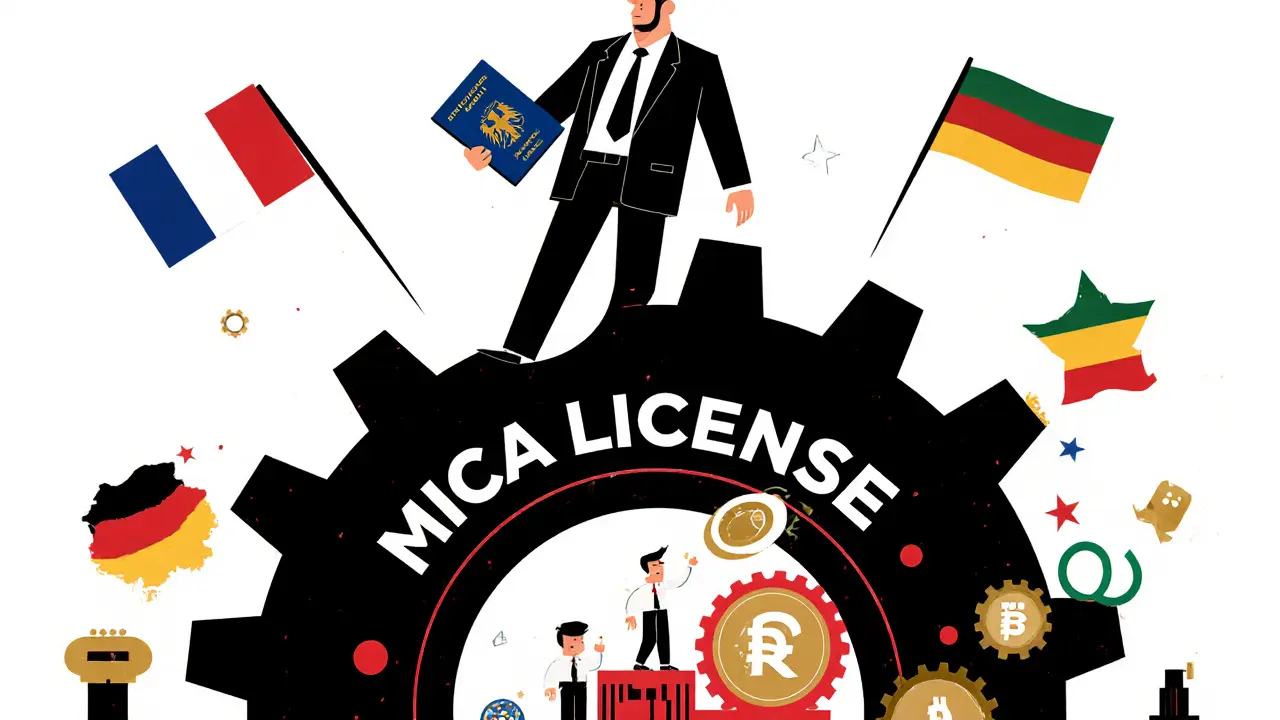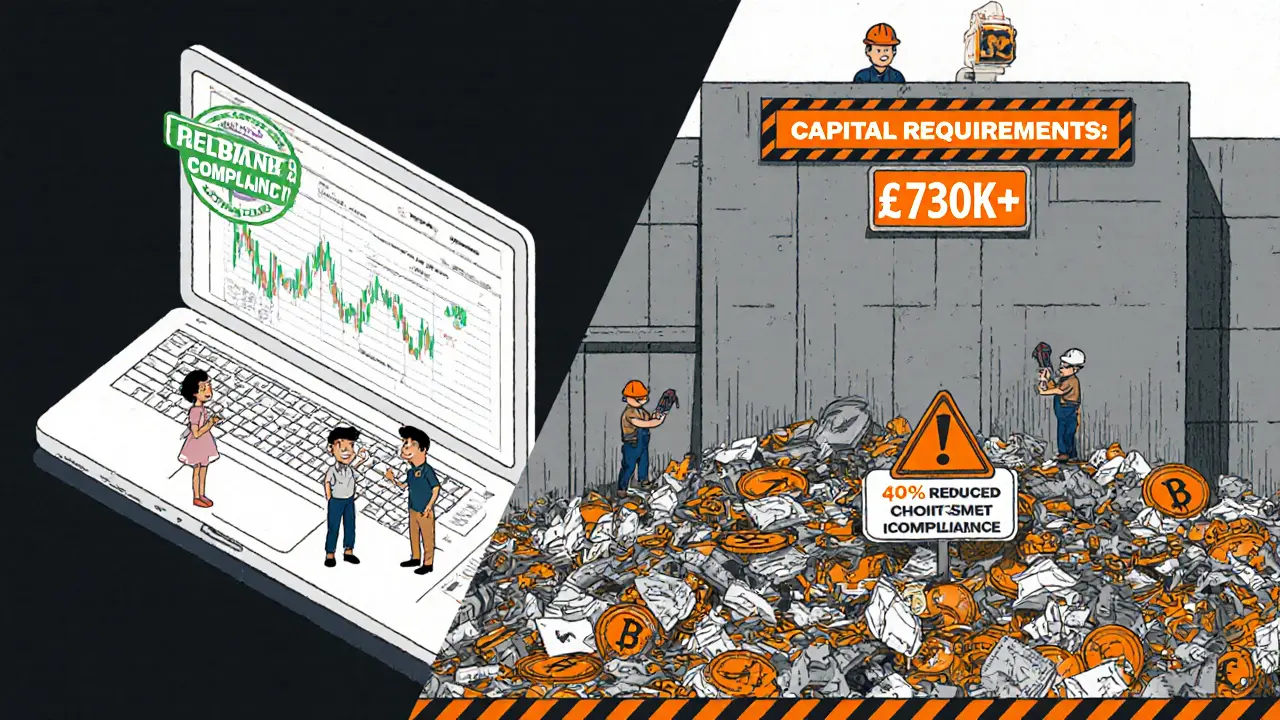Crypto Asset Service Provider Licensing in EU: MiCA Requirements, Costs, and Real-World Challenges
 May, 26 2025
May, 26 2025
CASP License Cost Calculator
Calculate Your CASP License Costs
Your Estimated CASP License Costs
Based on EU MiCA regulations (December 2024)
Starting a crypto business in the EU isn’t just about building a platform or writing smart contracts anymore. Since December 30, 2024, if you want to offer crypto services to customers anywhere in the European Union, you need a Crypto Asset Service Provider (CASPs) license under MiCA - the Markets in Crypto-Assets Regulation. This isn’t a suggestion. It’s the law. And if you’re still operating without one, you’re breaking it.
What Exactly Is a CASP?
A CASP is any company that provides one or more crypto services to clients on a professional basis. That includes custody services, trading platforms, exchanging crypto for euros or dollars, executing trades for customers, selling new crypto tokens, or even giving financial advice about crypto. It doesn’t matter if you’re a startup in Lisbon or a firm based in Singapore - if you serve EU customers, you need to be licensed.There’s no loophole for decentralized platforms. MiCA only covers legal entities with a physical presence and identifiable management. That means most DeFi protocols, DAOs, and anonymous smart contracts are effectively blocked from operating legally in the EU. A University of Zurich study found that 68% of DeFi projects have chosen to avoid the EU entirely because of this.
The One-Stop Passport System - And Why It Matters
Before MiCA, crypto firms had to get licensed in each EU country separately. That meant dealing with 27 different regulators, 27 sets of rules, and costs that could hit €350,000 per country. Now, you apply once. Get approved by one National Competent Authority (NCA) - like France’s AMF, Germany’s BaFin, or Lithuania’s Bank of Lithuania - and you can offer services across all 27 EU countries.This passporting system is the biggest reason why firms are applying. Kraken got licensed in France in March 2025 and expanded to 15 other EU markets within 30 days. Bitstamp got approved in the Czech Republic and went live across the bloc in weeks. No extra paperwork. No new applications. Just one license, one approval, full EU access.
But here’s the catch: the approval process is slow, uneven, and under-resourced. Germany’s BaFin takes an average of 6 months. Spain’s CNMV takes 9. Estonia’s processing time has stretched to 11 months. ESMA’s own data shows 42% of NCAs don’t even have enough staff to handle crypto applications properly. One founder on Reddit said they submitted to France’s AMF in January 2025 - and still had no decision six months later. MiCA says 6 months. Reality says otherwise.
How Much Does It Cost to Get Licensed?
This isn’t a cheap process. The minimum capital requirements alone are steep:- €125,000 for custody services
- €150,000 for exchange services
- €730,000 for operating a trading platform
But capital is just the start. You’ll need:
- An EU-based legal entity with at least one director living in the country where you apply
- A full AML/KYC system compliant with the 6th Anti-Money Laundering Directive
- Data security systems that meet the NIS2 Directive standards
- Environmental impact reports detailing your energy use - yes, even if you use proof-of-stake
- Transaction monitoring tools costing up to €1.2 million to implement
- At least 5-7 full-time compliance staff dedicated to MiCA
PwC’s August 2025 report found the total cost of authorization ranges from €750,000 for basic custody to €2.5 million for a full trading platform. For smaller firms, that’s more than their entire annual revenue. And if you’re not based in the EU, you’re facing an even steeper hill: 68% of non-EU applicants underestimated how hard it is to set up local management.

Who Counts as a ‘Significant CASP’?
If your platform has more than 15 million active EU users, you’re automatically labeled a ‘significant CASP’ (sCASP). That brings extra rules:- Quarterly stress tests
- Annual third-party audits
- Real-time transaction monitoring
- Direct supervision by your NCA - not just paperwork, but active oversight
That’s why giants like Kraken, Bitstamp, and Coinbase are rushing to get licensed. They’re not just complying - they’re positioning themselves as the only safe, legal options for EU users. Meanwhile, smaller players are getting squeezed out. As of August 2025, 89 firms are authorized - but they control 62% of all EU crypto trading volume. The market is becoming a two-tier system: big players with deep pockets, and everyone else trying to survive.
The Environmental Reporting Trap
One of MiCA’s most controversial rules is the requirement to report energy consumption. Even if your platform runs on proof-of-stake - which uses 99.9% less energy than Bitcoin mining - you still have to calculate and publish your environmental impact using the EU’s Blockchain Observatory methodology.Industry groups like Blockchain for Europe call this a joke. They say it ignores technological progress and adds €200,000-€500,000 in annual compliance costs for mid-sized exchanges. Professor Angela Walch from the University of Luxembourg called it ‘the green mirage’ - a regulatory box-ticking exercise that doesn’t reduce emissions but stifles innovation.
Still, it’s mandatory. And if you don’t report, you don’t get licensed. Even firms that use zero-energy consensus mechanisms have to submit reports. It’s not about reality - it’s about perception.
Stablecoins and the Reserve Problem
MiCA requires asset-referenced tokens (like USDC or EURC) to hold 1:1 reserves in cash or cash equivalents. Sounds simple. But the European Banking Authority warned in March 2025 that this might not be enough during a crisis. Remember the USDC depeg in March 2023? That happened even though it was supposedly fully backed.Now, regulators are asking: What if a bank holding those reserves fails? What if there’s a run on stablecoins? MiCA doesn’t require those reserves to be held in liquid, immediately accessible assets - just ‘equivalent value.’ That’s a gap. And experts say it could trigger another collapse.

What Happens After You Get Licensed?
Getting approved isn’t the end. It’s the beginning of ongoing compliance:- You must disclose all crypto assets you list - and only those that meet MiCA’s strict safety criteria. Many altcoins have been removed from EU platforms because they don’t qualify.
- You’re required to show users mandatory risk warnings before every trade. Users hate them. 41% of negative reviews on Trustpilot call them ‘excessive’ and ‘bad for UX’.
- You need to segregate client assets from your own. No mixing funds. Ever.
- You must prove you have enough reserves to cover all client holdings - proof-of-reserves is now mandatory.
These rules are working. Trustpilot ratings for MiCA-licensed exchanges average 4.1/5, with 63% of users praising improved security and transparency. But they’re also reducing choice. The number of available crypto assets on EU platforms has dropped by nearly 40% since MiCA launched.
Who’s Winning? Who’s Losing?
The winners are clear:- Large exchanges with global reach (Kraken, Bitstamp, Coinbase)
- Traditional financial firms (J.P. Morgan found 78% of banks won’t enter crypto unless it’s MiCA-compliant)
- EU countries with strong regulators (France, Germany, Lithuania)
The losers:
- Small crypto startups without deep pockets
- DeFi protocols that can’t identify a legal entity
- Users who want access to niche tokens or lower fees
- Non-EU firms that thought they could operate remotely
And then there’s the gray area: firms still operating under old national licenses. As of May 2025, 34% of crypto businesses in the EU are still under pre-MiCA rules. But that ends on July 1, 2026. After that, no exceptions. No grace period. No warnings.
What’s Next? MiCA 2.0 and the Future
The European Commission is already working on MiCA 2.0, expected in late 2025 or early 2026. This version aims to tackle DeFi, NFTs, and algorithmic stablecoins using a ‘functional approach’ - meaning regulation based on what a service does, not what it’s called.Real-time transaction monitoring starts January 2026. The new Anti-Money Laundering Authority (AMLA) will take over cross-border AML supervision in June 2026. And while the Digital Euro is still speculative, regulators are quietly preparing for integration.
For now, the message is clear: if you want to operate in the EU crypto market, you need to be licensed, compliant, and ready for long-term oversight. There’s no shortcut. No workaround. Just one path - and it’s expensive, slow, and unforgiving.
Do I need a CASP license if I’m based outside the EU?
Yes. If you serve EU customers - even one - you need a CASP license. MiCA applies based on where your users are, not where your company is registered. Non-EU firms must set up a legal entity within the EU and appoint a local director. You can’t operate remotely under MiCA.
How long does it take to get a CASP license?
MiCA says 6 months, but in practice, it takes 6-11 months depending on the country. Germany takes around 6 months, Spain 9, and Estonia has hit 11. Delays are common due to understaffed regulators. Start early and prepare for a longer wait.
Can DeFi platforms get licensed under MiCA?
No. MiCA only applies to legal entities with identifiable management and a registered office. DeFi protocols, DAOs, and anonymous smart contracts don’t qualify. That’s why 68% of DeFi projects have chosen to avoid the EU market entirely.
What happens if I don’t get licensed by July 2026?
After July 1, 2026, operating without a CASP license in the EU is illegal. You could face fines, asset freezes, or criminal charges. EU regulators will block your services, and payment processors will cut you off. There will be no grace period.
Is MiCA better than U.S. crypto regulation?
It’s more predictable. The U.S. has no unified crypto framework - firms must comply with the SEC, CFTC, and 50 state regulators. MiCA gives you one rulebook for 27 countries. But MiCA is stricter on capital, environment, and disclosure. The U.S. is looser but riskier. For pan-European operations, MiCA wins. For global reach, U.S. rules may be easier to navigate - if you can survive the legal chaos.